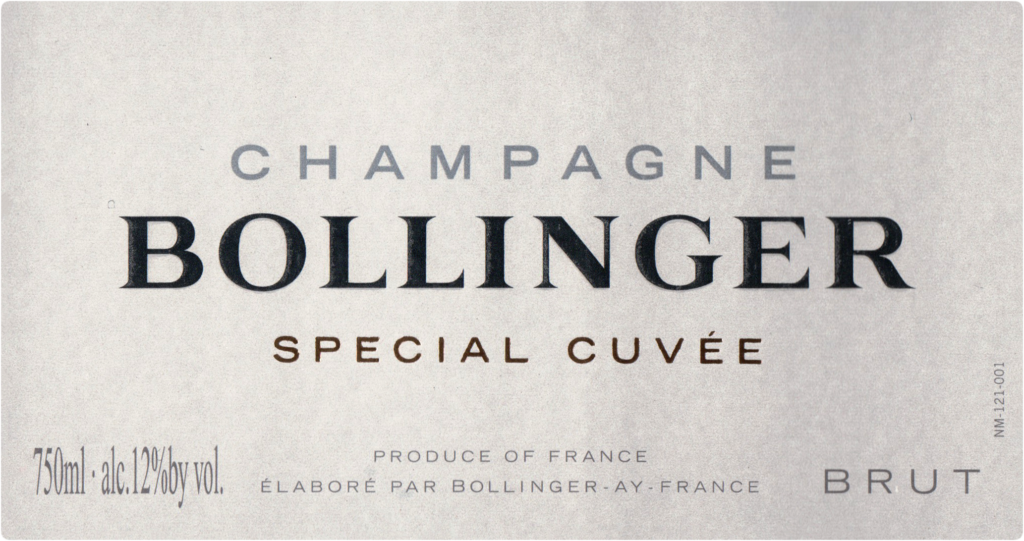
The label of Champagne bottles are full of helpful information which gives all the details and qualities of the Champagne you are dealing with. Some of them are almost standard for all types and brands of Champagne.

- The word CHAMPAGNE is prominently printed on the label. In this case one can safely assume that this is a bottle of Champagne from the Champagne region. If the label says, Champ noise, Methode traditionel or something like that, than you’re not dealing with Champagne.
- The Champagne house that produced the Champagne (Delamotte, for example)
- The type of Champagne (Extra brut ,Brut Integral ,Brut Zero with 0 % liqueur, Brut with 1% liqueur, Extra-sec with 1-3%liqueur, Demi-Sec/dry with 3-5% liqueur, Doux with 8-15% liqueur).
- The place or the region where the Champagne was produced (Reims, Epernay,Hautvillers etc.)
- The percentage of alcohol (often 12%).
- The size of the bottle (0,187 litre, 0,375 litre, 0,75 litre 1,5 litre, 3 litres, 9 litres, 12 litres, 15 litres).
- The name of the Champagne: Cuvee speciale, Brut Imperiale , Vintage 1900, for instance. If nothing is said on the label than it is often just an “ordinary” Champagne.
- The harvesting year (often only when the year was good).
- Registration code NM-XXX-XXX ( tells you what kind of producer you’re dealing with)
Current registration codes are to be found in the following schedule:
- RM Récoltant-Manipulant: a wine farmer who sells his grapes to the Champagne houses but also uses his grapes to make his own Champagne.
- CM Coopérative –Manipulant. A Cooperative of growers that also make their own Champagne under their own Label
- RC Récoltant –Cooperative. A grower who sells Champagne that is made by a cooperative under his own name.
- SR Société des Récoltants. A firm founded by two or more growers who share their vineyards and their put their Champagne on the Market under more than one brand name.
- ND Négociant-Distrubuteur: a firm that offers Champagne that it did not manufacture itself.
- MA Marque d’Acheteur: a brand name owned by a buyer such as a Super-market, a restaurant or a wine merchant.

A Champagne made from the harvest of one particular (good) year is called a Millésimé Champagne. The label will show the year in which the grapes were harvested. Champagne that does not mention the year on the label is called a Non Vintage (or NV) Champagne. This kind of Champagne has been composed of grape juices from harvests of several years. Often a Millésimé from one particular producer is of better quality than his NV Champagnes. However it is not necessarily so that a NV from a certain supplier is inferior to a Millésimé from another one.
A Champagne that is made of solely Chardonnay is called Blanc-des-Blancs (BdB). This type of Champagne is mainly made by producers that grow only Chardonnay grapes. (in the Côte des Blancs). Many producers however keep BdB in their range of Champagnes because of its unique lightness and freshness which offers. an excellent combination with fish.There are also white (which means blanc) Champagnes that are made from black (Blue) Pinot Meunier and/or Pinot Noir grapes. These are called Blanc-des-Noirs (BdN).The majority of the BdN’s are made of 100% Pinot Meunier. The BdN’s are reputed for their character spiciness and force. That is the reason why genuine wine lovers prefer BdN champagnes over the normal ones or the BdB’s.
Read more in the book “Christie’s Encyclopedia of Champagne and Sparkling Wine“
Blanc-des-Noirs are booming. Probably a bit too much. A number of producers are manufacturing BdN’s with an overdose of Pinot Meunier. The customer thinks that he bought a BdN for long storage and after some 10 years he opens a bottle of vinegar….
Rosé Champagnes are made by using a large amount of Pinot Noir. Sometimes the red grapes are pressed a little longer and/or the red skins are included in the fermenting process to obtain the colour. Of course producers call these Champagnes “pure”. Common practice however is to add 5-20% red Pinot Noir to the Champagne mix before storing the bottles for maturing. Champagne to which red wine is added is not “pure”. On the other hand they don’t have the bitter taste of the skins. It is up to you to decide what you prefer.
Once or twice I saw that after maturing, red wine was added to the Champagne that was subsequently sold as Rose. Some people think that bizarre. After all the whole trick of processing Champagne is that the entire mixture goes through the second fermentation in the bottle and also matures in that bottle. But considering the fact that pressing red grapes with such force that the colour of the skin is to be found in the juice will give you the bitter flavour of the skins free of charge… Let it ferment for a bit and you’re bound to taste that on your bubbles. Let’s say: “To each his own”…
Sometimes producers like to mix an addition of their own to the Champagne wine. Examples are Cuvée Speciale, Premier Cru, Vintage, Milliésimé, etc. (comparable to the Cl, Xl, and Gl identifications of cars). Since such an addition is unique for one particular producer one cannot compare sparkling wines starting from this addition. Within the supply of one particular producer however, it is of course possible to make a distinction on the basis of what is added.
On the label you will often find a catchword that indicates the sugar content (sweetness) of the Champagne.
